Data Insights
New Data Shows the Dangerous Side of Holiday Travel, Plus Tips on Staying Safe
December 6, 2023
Senior Applied Scientist

As we travel for the holidays, "drive safely!" is one of the things we hear most. This year, the message will be especially important: Nearly half the country plans to travel between Thanksgiving and the middle of January, according to the 2023 Deloitte Holiday Travel Survey.
For the professional drivers who work through the busy end-of-year holiday season, more vehicles on the road—combined with obvious hazards like snow, rain, and ice—could lead to more dangerous trips. To identify the trends and common risks of driving during the holidays, the Samsara Data Science and Analytics team took a closer look at the driving behaviors of tens of thousands of organizations in 2022 and 2023.
Interestingly, we found that risky driving behaviors often don't peak during holiday weeks themselves. Rather, these issues are more common in the weeks leading up to and following holidays. Read on to learn more about what we discovered about holidays throughout the year.
Harsh braking common around Thanksgiving, speeding is highest in the Northeast.
Sudden, hard braking—also called harsh braking—is highly associated with on-the-road crashes for commercial drivers. In fact, one study found that harsh braking is one of the most likely predictors of future crashes.
For this reason, any rise in harsh braking is cause for concern, and our data showed higher levels of this behavior surrounding the Thanksgiving holiday. Harsh braking was 22% higher the week before Thanksgiving, compared to the week of the holiday. Furthermore, harsh braking was 13% higher in the week after Thanksgiving, compared to Thanksgiving week. We also identified the top 10 states where drivers experience the most harsh braking during November and December 2022.
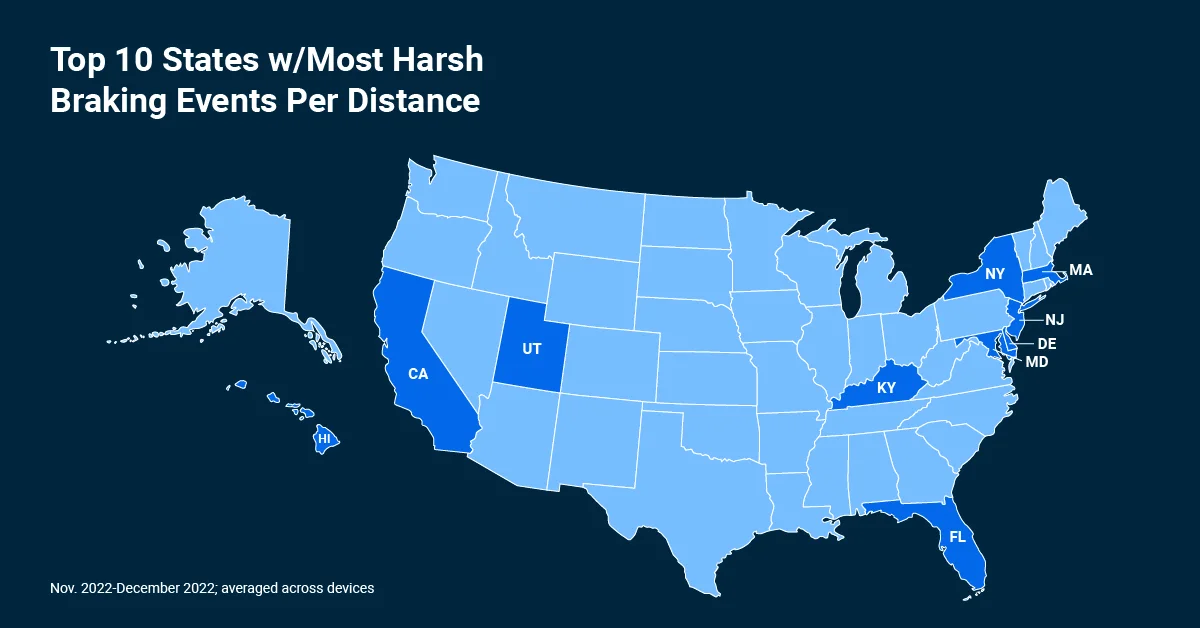
When we looked at incidents of speeding, as compared to Thanksgiving week, we found that incidents were 21% higher the week before and incidents were 22% higher the week after. However, speeding was not uniform across the country, as is the case with harsh braking, where incident rates are more consistent. Many of the states with the highest level of speeding per trip were clustered in the Northeast, including Connecticut, New Hampshire, Delaware, and Maryland.
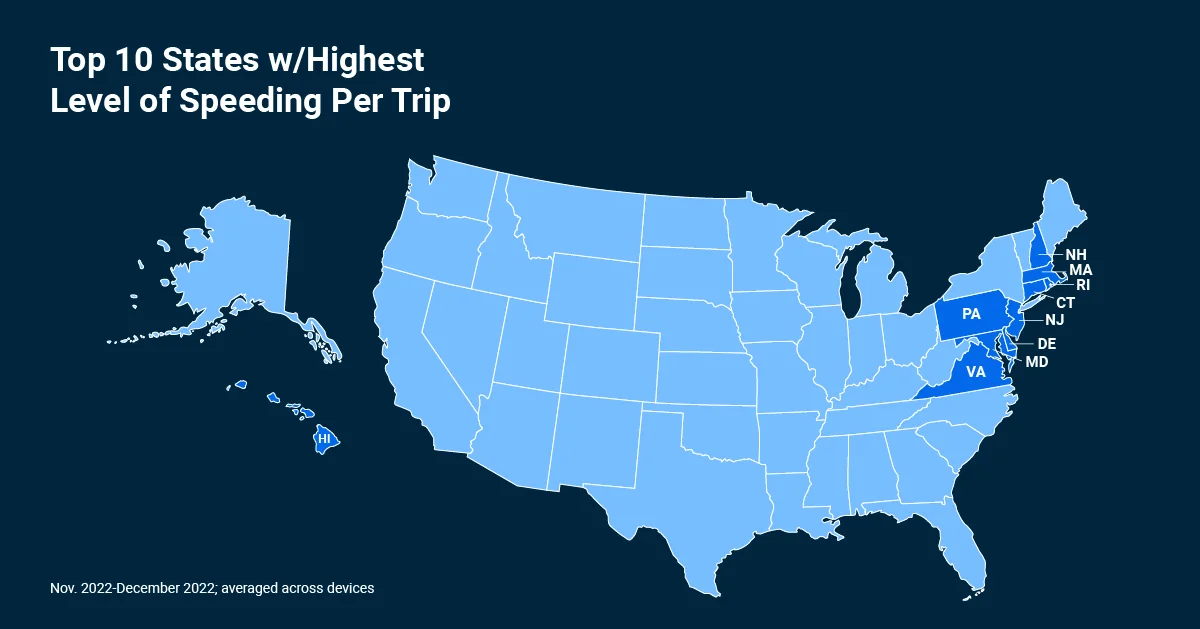
We also noticed trends in what time of day drivers speed the most. Trips where speeding occurs are more likely to start mid-morning, 9:00 am to 11:00 am, while they are least likely to start late at night, 10:00 pm to 1:00 am.
These results suggest that professional drivers aren’t speeding when there is a relatively open road in front of them late at night, but rather at times when there are likely more drivers on the road. Our data reflects conclusions from the NHTSA that show traffic congestion is a top contributing factor to aggressive driving behaviors, including speeding.
Moreover, traffic volume is typically higher around the holidays. In 2022, we found that trip volume was 37% higher the week before Thanksgiving compared to Thanksgiving week. Data from organizations like the National Safety Council point to increased traffic volume as a major risk factor for road accidents around major holidays.
Traffic, harsh braking, and speeding have been highly correlated in our data, and although the 2023 winter holiday season is only just beginning, our data indicates these trends will likely persist.
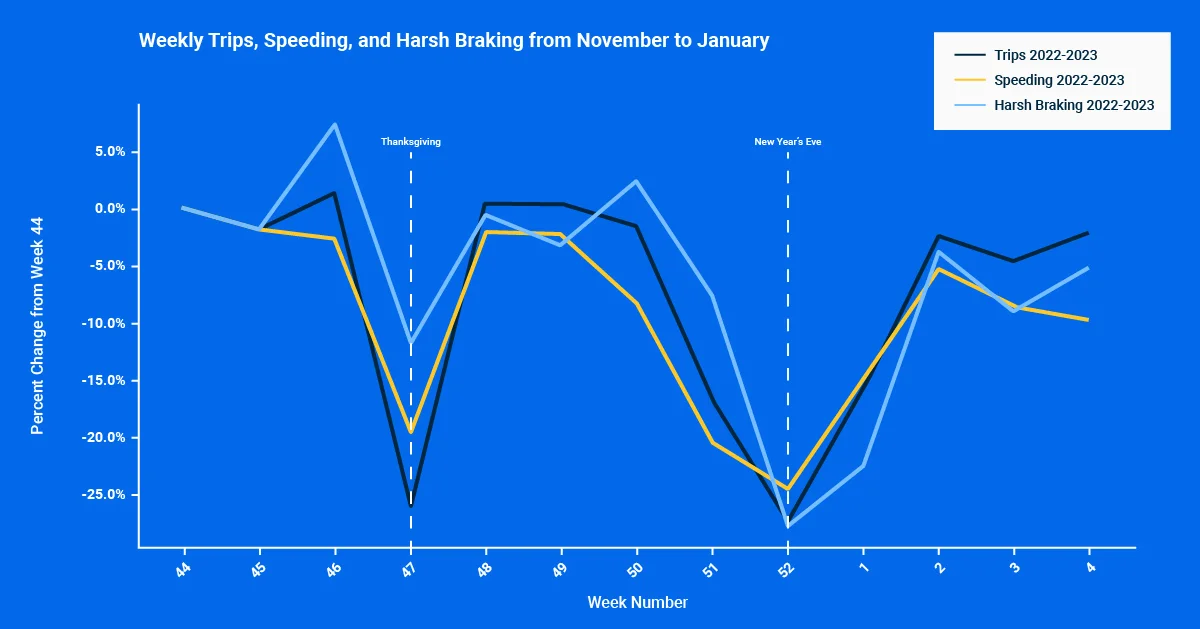
Graph illustrates the weekly percentage change relative to the baseline value from the first week of Nov. (week 44). Shows the normalized number of trips, average time spent speeding, and harsh braking between Nov. and early Jan.
It’s not just during the expected end-of-year season—risks increase around many major holidays.
Unsafe driving behaviors like speeding and harsh braking fluctuate across weeks of the year, especially around holidays. In fact, according to the National Highway Traffic Safety Administration, there are generally more motor vehicle traffic crash fatalities during holiday periods than during non-holiday periods.
For every holiday, there are busier and less busy times. For example, our data showed that speeding incidents were 9% higher the week before Independence Day and incidents were 10% higher the week after in 2022. A similar trend occurred in 2023 when we saw that speeding incidents, compared to the week of Independence Day, were 15% higher the week before and incidents were 14% higher the week after.
These swings suggest that in some instances commercial drivers might be shifting activity away from holiday weeks to those before and after holidays. As they do, however, they might end up with more trips during weeks that have relatively higher speeding and harsh braking rates. Overall, higher levels of speeding and harsh braking incidents are consistent from year-to-year around holiday time periods.
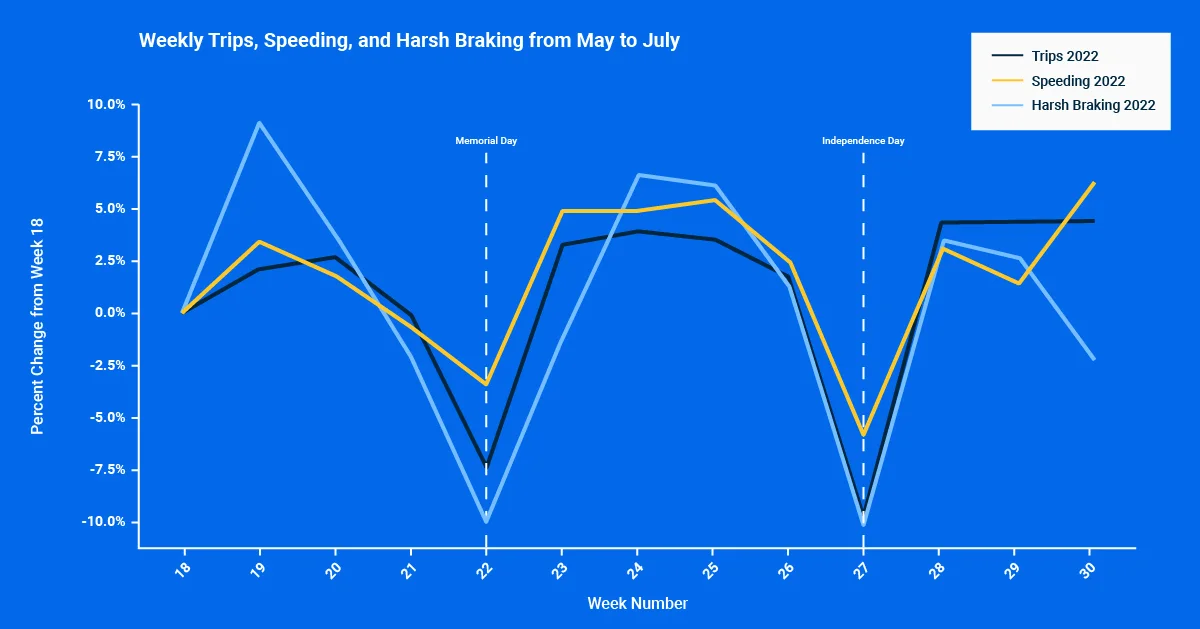
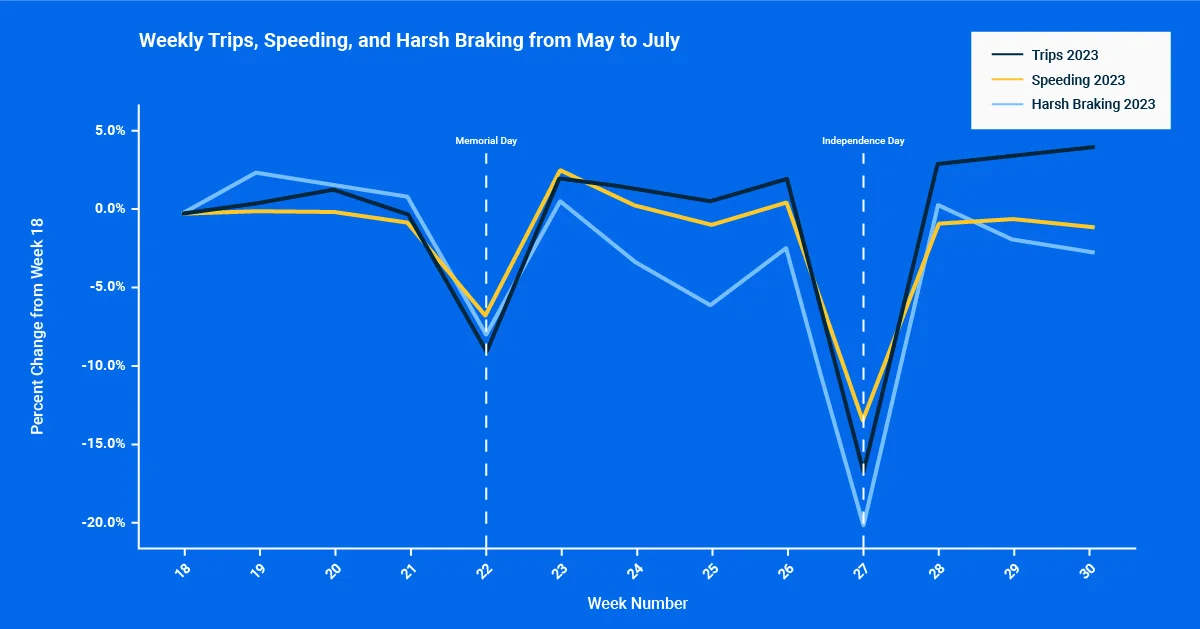
Graph details: Illustrates the weekly percentage change relative to the baseline value from the first week of May (week 18). Shows the normalized number of trips, average time spent speeding, and harsh braking between May and July in 2022 and 2023.
Coaching is the key to keeping drivers safe, during holidays and beyond.
As roads become busier, organizations will face increasing risk from unsafe driver behaviors. That’s one reason why now is an ideal time to focus on better coaching, both to alert drivers to increased dangers around the holidays, as well as increase safety on the road regardless of the time of year.
One company that is proactive about safety year round is Glazer's Beer & Beverage, one of the largest wholesale beer distributors in the United States. "The end-of-year holidays are a really busy time for us, but safety is a priority every day," says Will Herrin, the company's Vice President of Operations. "In order to make it part of our company culture, we have to make it an obsession and focus on it every day. We have a really well-defined safety program that we are very serious about."
Glazer's safety program includes a driver coaching program that uses footage from Samsara AI Dash Cams to help managers address unsafe behaviors. "We focus on speeding and mobile usage, and we coach those behaviors," Herrin says. "We also use in-cab alerts for speeding and seat belt usage, so drivers can correct behaviors on their own."
Tips for safer driving over the holidays, or any time of year.
It’s not just the professionals who have a responsibility to help increase safety on the road. Regular drivers often find themselves driving more during busy holiday periods. Here are three tips we rounded up from professional drivers with decades of experience and exceptional safety records to help everyone drive more safely:
Watch out for distracted driving: Ina Daly, a driver with XPO who has 40 years of experience, says: “You can tell a distracted driver by their fluctuating speed... They're drifting in their lane. Their head is looking down instead of focusing on the road. You want to give those people a wide berth.”
Add extra time to your driving itinerary: Daly also points out the importance of not adding to the holiday rush by giving yourself more time to get where you’re going. She says: “You don't want that stressful drive. You’re hurrying. That lends to bad driving behaviors like tailgating and speeding, which leads to accidents. Don’t put yourself in that situation.”
Remember to respect trucks and other non-passenger vehicles: Robert Chidester, a driver for RelaDyne with 45 years of experience and a Samsara Top Driver award winner, notes that not all vehicles behave the same way. He says: "Some people think driving a truck is exactly like driving a car, but it’s not. It doesn’t stop like a car, it doesn’t go around corners like a car, and it can’t go uphill like a car. Some people on the road get really frustrated with trucks, but I think they just don’t understand how a truck needs to operate and drive on the road. Just give us some patience and remember that we’re driving the way a truck needs to be driven safely."
Appreciating the drivers who help make our holidays special.
The fact is that the roads will be busier than usual during the holidays and professional drivers will be working hard to do their jobs safely and efficiently. As many of us take time to relax with friends and family, it's important to take extra care while we're on the road, and show our appreciation for drivers and the vital role they play in making our holiday celebrations special.
Methodology
The statistics shown are based on a review of anonymized historical data of Samsara customers in the United States. The customer cohort included tens of thousands and findings were based on the same organizations for 2022 and 2023. Harsh braking and speeding were established by Samsara Vehicle Gateway detections.

